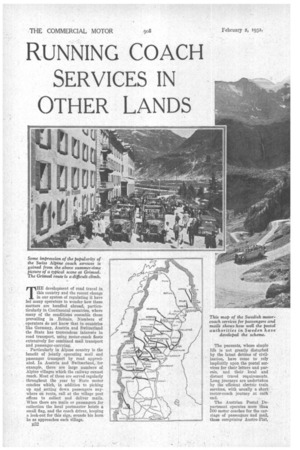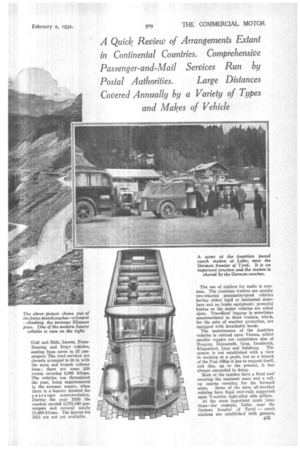RUNNING COACH SERVICES IN OTHER LANDS
Page 110

Page 111

Page 112

If you've noticed an error in this article please click here to report it so we can fix it.
A Quick Review of Arrangements Extant in Continental Countries. Comprehensive Passenger-and-Mail Services Run by Postal Authorities. Large Distances Covered Annually by a Variety of Types and Makes of Vehicle
THE development of road travel in this country and the recent change in our system of regulating it have led many operators to wonder how these matters are handled abroad, particuticularly in Continental countries, where many of the conditions resemble those prevailing in .Britain. Numbers of operators do not know that in countries like Germany, Austria and Switzerland the State has tremendous interests in road transport, using motor-coach fleets extensively for combined mail transport and passenger-carrying.
Particularly in Alpine country is the benefit of jointly operating mail and passenger transport by road appreciated. In Austria and Switzerland, for example, there are large numbers of Alpine villages which the railway cannot reach. Most of these are served regularly throughout the year by State motor coaches which, in addition to picking up and setting down passengers anywhere en route, call at the village post offices to collect and deliver mails. When there are mails or passengers for collection the local postmaster hoists a small flag, and the coach driver, keeping a look-out for this sign, sounds his horn he as approaches each village.
E52 The peasants, whose simple life is not greatly disturbed by the latest deVices of civilisation, have come to rely implicitly upon the postal services for their letters and parcels, and their local and distant travel requirements. Long journeys are undertaken by the efficient electric train services, with usually a short motor-coach journey at each end.
The Austrian Postal Department operates more than 500 motor coaches for the carriage of passengers and mall, these comprising Austro-Fiat, Griif und Stift, Saurer, FrossBussing andSteyr vehicles, seating from seven to 37 passengers. The road services are cleverly arranged to fit in with the main and branch railway hues; there are some 250 routes covering 8,000 kiloms. The vehicles run throughout the year, being supplemented in the summer season, when there is a heavier demand for passe nger accommodation. During the year 1930 the coaches carried 5,778,340 passengers and covered nearly 13,400 kiloms. The figures for 1931 are Dot yet available.
The use of trailers for mails is common. The Austrian trailers are usually two-wheeled pnenmatie-tyred vehicles having either rigid or laminated drawbars and no brake equipment ; powerful brakes on the motor vehicles are relied upon. Travellers' luggage is sometimes accommodated in these trolleys, which, for the sake of weather protection, are equipped with detachable hoods.
The maintenance of the Austrian vehicles is centred upon Vienna, whilst smaller repairs are undertaken also at Dregenz, Eisenstadt, Graz, Innsbruck, Klagenfurt, Linz and Salzburg. The system is not established with a view to working at a profit, but as a branch of the Post Office it has to support itself. and this, up to the present, it has always succeeded in doing.
Most of the coaches have a fixed roof covering the rearmost seats and a rolllip canvas covering for the forward seats. Some of the later all-weather vehicles have fixed cant-rails supported upon T-section light-alloy side pillars.
At the more important route junctions—for example, Later, near the German frontier of Tyrol — coach stations are established with garages, parking grounds and comfortable amenities for passengers—as in England.
Vehicles Used in Germany.
The German post system employs coaches seating from seven to 45 persons. In the past few years some steelframed vehicles with all-weather heads have been introduced. The vehicles are assembled at the Reichspost works, mainly at Berlin, Breslau, Erfurt, Dortmund, Karlsruhe, Bamberg and Stuttgart. An arrangement exists by which rail and motor-coach services are closely co-ordinated. The system is far-reaching and results in the use of about 4,000 coaches, each covering on an average about 21,000 kiloms. yearly.
In Switzerland the postal authorities
have the sole right to the regular conveyance of passengers, but are permitted to grant concessions. Accordingly, in addition to services operated by the authorities, there are services run on account and at the risk of the "Poste" and services worked, under concession, by private enterprise. The latter are generally obliged to carry postal matter, for which they are paid, except in the case of urban buses.
In the case of services run on behalf of the authorities, contractors supply their own vehicles and drivers, and receive a fixed rate per kilometre covered, together with 10 per cent, of the receipts. The State Department runs its own services only where several lines can be operated together as a group, also on difficult routes in the Alps.
Most of the private contractors work on a five-year agreement, and a large number of them employ six-seater vehicles, having mail compartments at the rear. In Switzerland nearly every village is linked with a railway station by means of a motor service, even in the mountainous districts.
As all vehicles must carry mails it is only in the town areas that the State has to provide special motors for mail transport. Concession services which, despite the income for mail transport, work at a loss, receive an indemnity amounting to 50 per cent. to 75 per cent, of the loss. The Poste runs 246 coaches, providing 4,280 seats, and there are 30 trailers. Contractors run 423 coaches (4,700 seats) and the services worked under concession employ 366 coaches (9,150 seats).
About 2,705,000 passengers are carried annually by the services under direct control, some 335,000 of these E54 being travellers on the Alpine routes. Contractors and concession operators account for nearly 15,000,000 passengers annually. A record of the weight of postal matter carried is not kept. The services under direct control cover about 4,000,000 vehicle-kiloms. and those run by contractors, etc., about 12,000,000 vehicle-kiloms. per annum.
Two of the contractors employ trailers seating from 40 to 50 persons, so that, together with the prime-mover, aggregate loads of from 80 to 100 passengers can be carried. Needless to say, such outfits operate only on comparatively level and straight roads, but the authorities have had no difficulties with them. Trailers are also used for carrying luggage and mails.
The Swiss authority runs only two goods services of its own, these being on routes which had to be taken over from concession companies. There are private forwarding agents all over the country with which the Government is not concerned. On the other hand, on various postal coach routes. goods of
weight tap to 50 kg. are -accepted, the traffic comprising mainly express par: eels, etc.
The central workshops are located in Berne, and it has been found more satisfactory to centralize all the overhaul work than to provide scattered workshops. Generally speaking, vehicles are completely overhauled after travelling 100,000 kiloms. Bodywork overhaul is done exclusively by private coachbuilders.
About 75 per cent. of the services under direct control are run at a loss, whilst the Alpine services show a profit, so that, on the whole, the system works without Government subsidy.
Some interesting details have recently reached us of the Swedish Postal De partment's combined mail-and-passenger services. The routes pass through exceedingly mountainous country, the roads of which are snow-covered throughout the long winter period. The longest route is that between Solleftea and Jormvattnet, a distance of 197i miles, the schedule time for which is 14i hours. The services connect up with the State railway system. Singledeck vehicles are employed, the mails being usually carried in two-wheeled trailers. An accompanying map indicates the widespread nature of the Swedish system.
French Railway Road Services.
In France the carrying of mails, as well as passengers, by road is a comparatively recent institution. All the great railway concerns, including the two State-owned railways, now run coach services, and the routes covered total well over 25,000 kiloms. Whilst most of the coach lines are seasonal, being intended for tourist traffic, there Is a small but steadily growing number of railway-operated town-to-town services running all the year round. These services, which are well managed, connect up with trains and carry mails. In some instances a letter-box is to be found on the side of the coach, whilst a two-wheeled trailer carries parcels.
The railway coach services of France are, without exception, run by contract. In addition to the railway-operated coaches there exist, in every department of France, regular town-to-town lines operated by subsidized private enterprise, and in some instances these lines carry mails. In such cases the subsidy is paid by the Prefect of the Department.




































































































































































